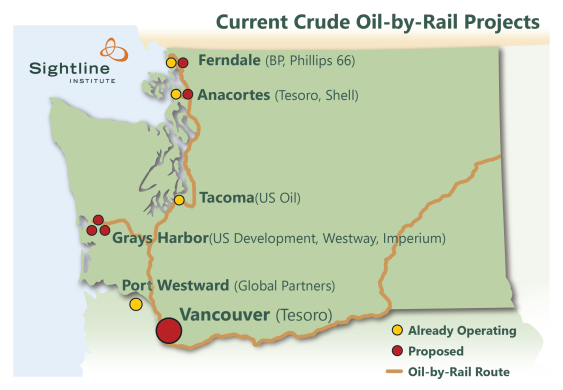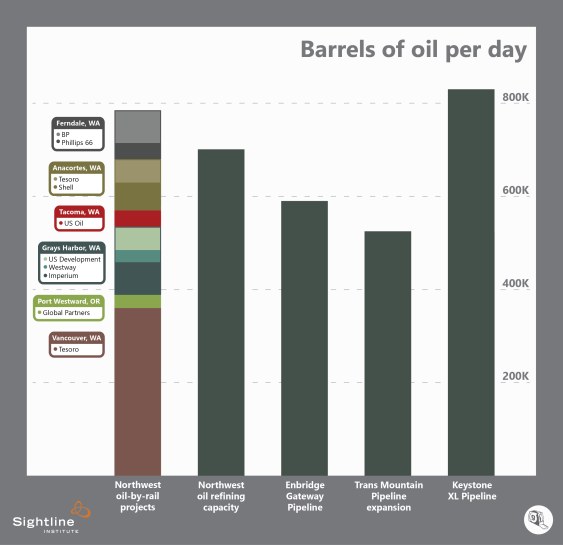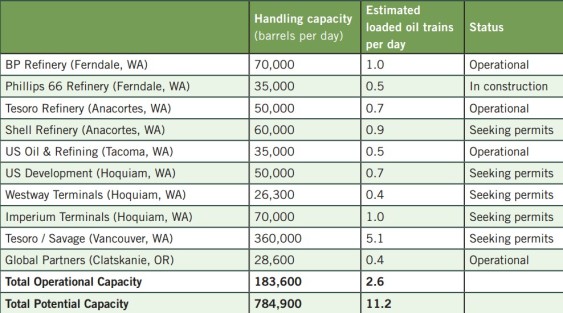Editor’s note: The report referenced below is a living document, and Sightline researchers update it regularly to reflect new developments. For the most recent facts and figures, please see the report, The Northwest’s Pipeline on Rails.
Sightline is re-releasing a popular report: The Northwest’s Pipeline on Rails. It’s the most comprehensive regional analysis of plans to ship crude oil by train.  Moving large quantities of oil by rail would represent a major change for the Northwest’s energy economy, and the plans now in development puts the region’s communities at risk.
Moving large quantities of oil by rail would represent a major change for the Northwest’s energy economy, and the plans now in development puts the region’s communities at risk.
Why does it matter?
- In Oregon and Washington, 10 refineries and port terminals are planning, building, or already operating oil-by-rail shipments.
- If all of the projects were built and operated at full capacity, they would put an estimated 11 loaded mile-long trains per day on the Northwest’s railway system. Many worry about the risk of oil spills from thousands of loaded oil trains that may soon traverse the region each year.
- A string of high profile oil train explosions has raised widespread concern about the risks of moving crude oil by rail through populated areas. States and local governments across North America are beginning to seek more information about oil shipments and demand stricter tank car standards from federal regulators.

- Taken together, the oil-by-rail projects planned for the Northwest would be capable of delivering enough fuel to exceed the region’s oil refining capacity. Ironically, two of the facilities that would handle oil by rail were originally built to supply renewable fuels.
- The projects are designed to transport fuel from the Bakken oil formation in North Dakota, but the infrastructure could also be used to export Canadian tar sands oil. In fact, if all of the oil-by-rail projects were built, they would be capable of moving 785,000 barrels per day—that’s more oil capacity than either of the controversial pipelines planned in British Columbia, and nearly as much as the planned Keystone XL pipeline.
- On Puget Sound, three of the region’s five refineries already receive oil-by-rail shipments, and the other two are planning new facilities. Three proposals for Grays Harbor would move oil along the Washington coast. And on the Columbia River, one port terminal is already receiving oil-by-rail shipments, while officials at Vancouver are planning by far the region’s largest facility.
Read the full report here: The Northwest’s Pipeline on Rails.










Jean Darsie
It appears that Sightline has the same myopic view of these fossil fuel shipments as the mainstream press. In other words, it ignores the impact on climate change and ocean acidification that burning all that fossil fuel would have. That’s the bottom line. Of course, local impacts are important such as spills, explosions, water and land pollution, traffic impediments, etc. are important but the bottom line is and should continue to be the effect burning these fossile fuels will have on climate change and ocean acidification. Local effects may be able to be mitigated but global effects cannot be and represent a global death sentence for future generations.
Eric de Place
Jean,
I’m sorry to hear that’s the way this analysis came across to you. In fact, we spend a lot of time researching and writing about the climate implications of fossil fuel shipments. See, for example, this report that I wrote last year tallying the aggregate carbon in coal, oil, and gas export schemes: http://www.sightline.org/research/northwest-fossil-fuel-exports/.
Jan W
“It appears that Sightline has the same myopic view of these fossil fuel shipments as the mainstream press…Local effects may be able to be mitigated but global effects cannot be and represent a global death sentence for future generations.”
Tomato? Tom-ah-to? Death sentence today? Death sentence for future generations? The one thing that cannot be debated—we’ve seen it happen in other communities—is that oil trains in Skagit County have the capacity to obliterate downtown Burlington, or downtown Mount Vernon, or Anacortes, or Puget Sound water quality, or bald eagle nesting sites, or the largest (recovering) heronry in Western America, or the Anacortes Water Treatment Plant’s potable water supply for 56,000 residential, business and commercial customers. The Bakken oil train that exploded last July in Quebec killed 47 people, leveled 30 buildings, displaced 115 businesses, and left 79 acres so contaminated that they will be uninhabitable for years to come (if at all). The company responsible for the oil-train explosion, which had a fraction of the liability insurance necessary to respond to such a disaster, declared bankruptcy and cannot be held accountable for the $200+ million cost for relief, recovery and rebuilding. This is another great example of “externalities” that oil company’s pass on to governments (i.e., taxpayers), which keeps gas prices addictively low. Jean, I couldn’t agree more: carbon emissions, climate disruption, and ocean acidification pose horrific problems for Earth’s systems and inhabitants, but “local effects” will only be mitigated if citizens demand it from their government leaders. That is why every one of us must do our best to shine a light on ALL harmful practices of those that put profits ahead of people and the planet. Thank you Sightline for the invaluable work you do to educate “We the People” about the policies and practices of Big Oil and other industrial polluters.
Jan W
I’m sorry for the previous typo: the estimated recovery costs for the Le Megantic, Quebec oil-train explosion is $200+ BILLION. The rail operator had just $25 million in liability insurance. How much liability insurance does the oil-by-rail operator rolling through YOUR community carry? Taxpayers, you should know that answer.
Daniel Reyes
Thank you for tis information.